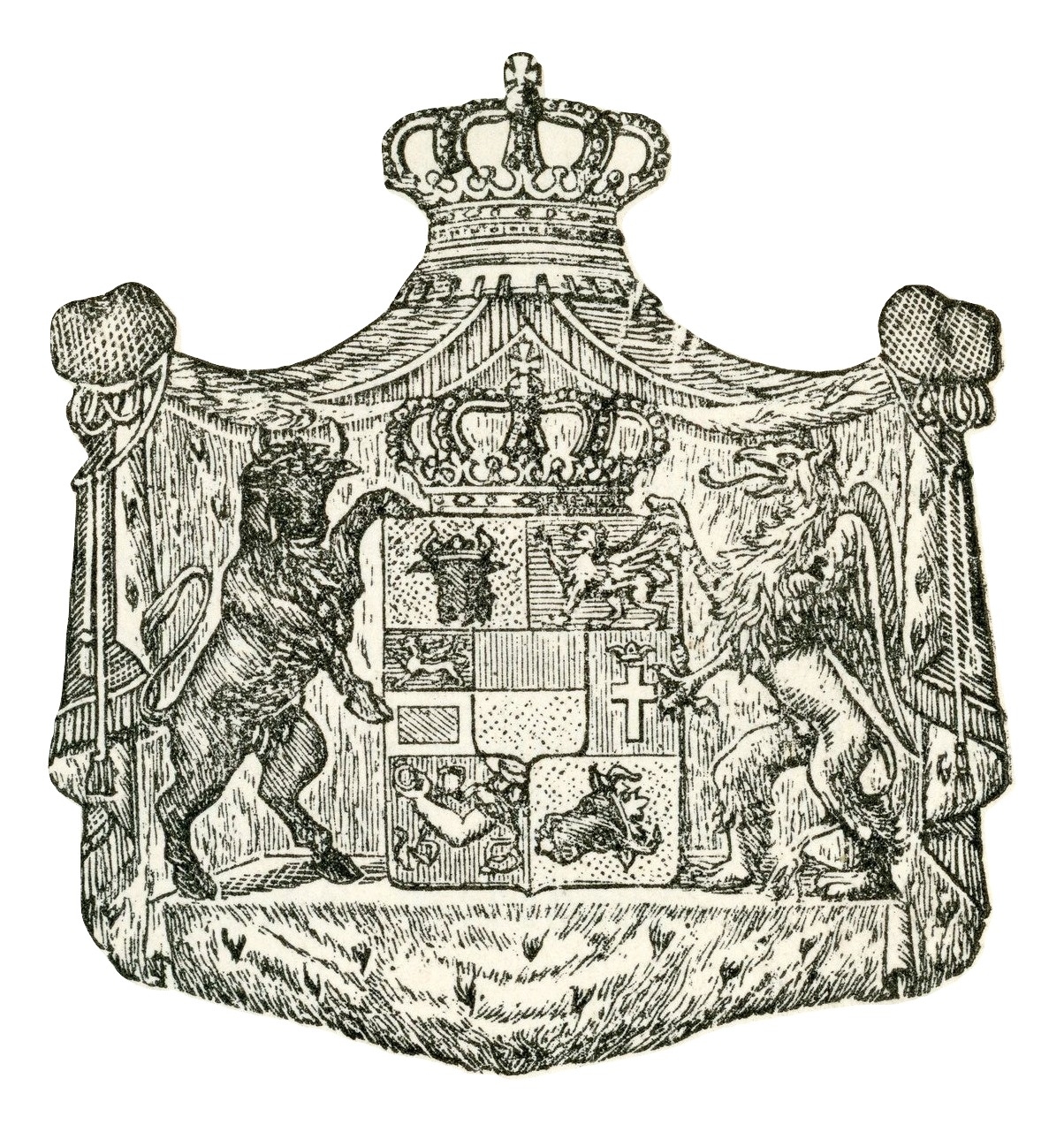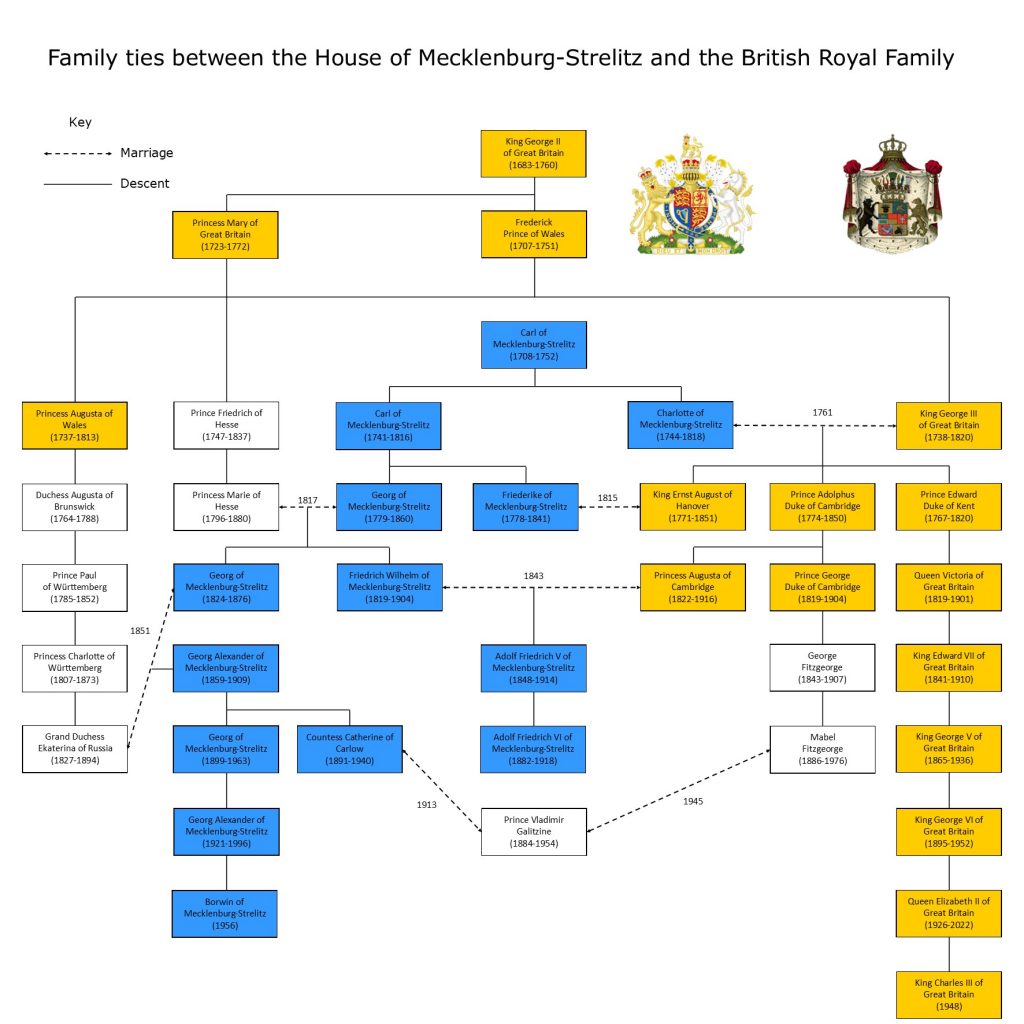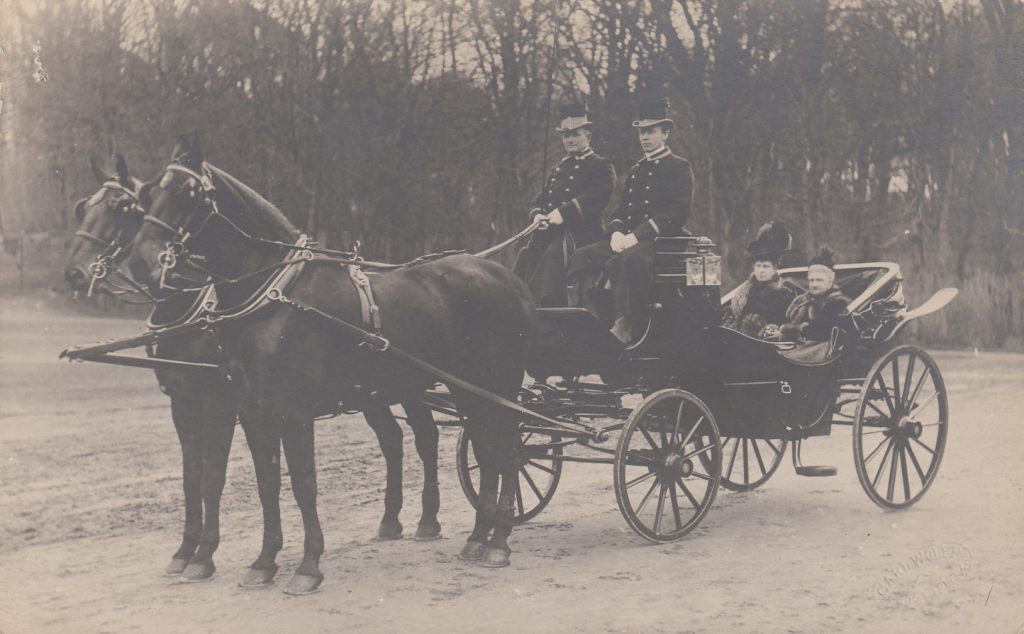Out of all the European countries the House of Mecklenburg-Strelitz has had particularly close ties with the United Kingdom of Great Britain and Ireland (now Northern Ireland) and its royal family. Relations between the two families were cemented by three marriages over three consecutive generations in the 18th and 19th centuries.
18th and 19th centuries
Family relations between the House of Mecklenburg-Strelitz and the British Royal House would first be established in 1763 by the marriage of Duchess Charlotte to King George III, a highly prestigious match that significantly raised the profile of the small Mecklenburg-Strelitz state. Amongst Queen Charlotte’s legacy in Britain is credit for the introduction of decorative Christmas trees, with the first known instance of this having occurred in Britain being the one she established at Queen’s Lodge, Windsor in December 1800.
Family relations were further cemented in the following two generations after Queen Charlotte by the marriages of her niece Duchess Friederike and son Prince Ernest Augustus, Duke of Cumberland (later King of Hanover) in 1815 and by her great nephew Grand Duke Friedrich Wilhelm and granddaughter Princess Augusta of Cambridge in 1843.
With these close family ties members of the House of Mecklenburg-Strelitz would serve as godparents to various members of the British Royal Family (and vice versa) beginning with the future King George IV, who was christened in 1762, and ending 134 years later with the future King George VI, who was christened in 1896. Among George IV’s godparents was his uncle Duke Adolf Friedrich IV while Grand Duchess Augusta and Grand Duke Friedrich Wilhelm were among the godparents of their great nephew George VI. The close family ties would also help the brothers of Queen Charlotte achieve high ranking positions in their brother in law King George III’s Brunswick realm with Grand Duke Carl becoming Governor of Hanover and Duke Ernst the Governor of Celle. The youngest brother Duke Georg served in the Royal Navy for a couple of years before ill health forced his departure. He is the only member of the House of Mecklenburg-Strelitz to have served in the British armed forces.
Members of the House of Mecklenburg-Strelitz became regular visitors to Britain attending important state events such as coronations and funerals, while also paying numerous private visits to their British relations. Grand Duke Friedrich Wilhelm and his wife Grand Duchess Augusta in particular made regular trips to the country staying with her parents at their residences Cambridge House, Kew and St. James’s Palace. After the death of her mother in 1889 Grand Duchess Augusta took out a lease on a house in Buckingham Gate, near Buckingham Palace, giving it the name Mecklenburg House which it retains to this day. A number of family events would take place in Britain as Grand Duke Friedrich Wilhelm and Grand Duchess Augusta’s eldest son Hereditary Prince Friedrich Wilhelm was born at Cambridge House in London on 13 January 1845 although he only lived for a few minutes, while their granddaughter Duchess Marie was married at Richmond and Kew to Count Georges Jametel on 22 June 1899.
20th and 21st centuries
With the marriage of Grand Duchess Augusta’s niece Princess Mary of Teck to the future King George V the ties between grand ducal family and the main line of the British Royal Family became even closer. In addition to their visits to Britain the Grand Duke Adolf Friedrich V and his family hosted King George V and Queen Mary at lunch in Neustrelitz on 26 May 1913, while their son the future King Edward VIII spent six weeks staying with the family earlier that year. Being immensely proud of her status as a British princess, the Grand Duchess Augusta was keen to install anglophile feelings in her son and grandchildren. She was most successful with her grandson Grand Duke Adolf Friedrich VI who became a regular visitor to the Britain and a popular member of London society in the years leading up to the First World War. During the war itself he used his contacts with his friend the British born German princess Daisy of Pless to enquire on the welfare of imprisoned British officer friends.
After the First World War ties between the British Royal Family and their German relatives became largely nonexistent although the British Royal Family did send a telegram of condolence after the death in 1933 of Grand Duchess Elisabeth, the widow of Grand Duke Adolf Friedrich V.
Members of the Russian branch of the House of Mecklenburg-Strelitz left that country in 1919 aboard British naval ship’s which had been instructed by King George V to rescue his surviving Imperial Russian relatives who were trapped in the Crimea with the Bolsheviks closing in. After leaving Russia the Countesses Catherine and Maria of Carlow, morganatic daughters of Duke Georg Alexander and Countess Natalia of Carlow, both settled in England with their families where they became prominent members of London’s Russian community. Prince Vladimir Galitizne, the widow of Countess Catherine of Carlow who was killed during a German bombing raid in 1940, was married for a second time in 1945 to fellow widow Mabel Iris Balfour (née Fitzgeorge) the granddaughter of Prince George, Duke of Cambridge and thus a great niece of Grand Duchess Augusta like his first wife Countess Catherine.
The second member of the family born in Britain after the Hereditary Prince Friedrich Wilhelm in 1845 was Duchess Helene the daughter of Duke Georg and Duchess Irina and a niece of the two Countesses of Carlow. She was born in St Leonard’s-on-Sea in Sussex on 15 November 1924 during her parents visit to the country.
In 1963, Duke Georg Alexander, his wife Duchess Ilona and their youngest son Duke Borwin moved to Ireland. The family lived at Culleen House, near Mullingar in County Westmeath, which was owned by Duke Georg Alexander’s brother in law Hassan Sayed Kamil’s Swiss businesses. The Culleen House estate was administered by Duke Georg Alexander, while Duke Borwin attended Headfort School near Kells in County Meath. The family’s time in Ireland came to a sudden end in 1969 with the collapse of Hassan Sayed Kamil’s Swiss businesses with his assets taken over and sold by the state. The family therefore had to return to West Germany.
In 21st century the children of Duke Borwin all received part of their education in either the United Kingdom or Republic of Ireland, with his two sons Hereditary Prince Alexander and Duke Michael studying at Wilson’s Hospital School in County Westmeath and Duchess Olga spending time in the Lake District in the United Kingdom. After leaving Wilsons, Hereditary Prince Alexander remained in Ireland to attend LIT Tipperary. Since leaving there in 2018 he remained in Ireland where he works at the state owned forestry company Coillte.
Succession to the British throne
The first member by birth of the House of Mecklenburg-Strelitz to be in the line of succession for the British throne was Duchess Luise, born 1818, daughter of Grand Duke Georg, who took her place in line after her mother Princess Marie of Hesse, a granddaughter of Princess Mary of Great Britain the second youngest daughter of King George II. By virtue of the marriages of her brothers Grand Duke Friedrich Wilhelm and Duke Georg, the next generation of the grand ducal house would occupy higher positions in the line of succession.
Through Grand Duke Friedrich Wilhelm’s marriage to Princess Augusta of Cambridge the couple’s two sons occupied prominent positions at the time of their birth. The couple’s only surviving son Grand Duke Adolf Friedrich V was born 14th in the line of succession and was the highest ranked person in the line of succession without a British royal title. The same was true for their elder son Hereditary Prince Friedrich Wilhelm who was born 10th in line, but he only lived for a few minutes.
Grand Duke Friedrich Wilhelm’s brother Duke Georg married Grand Duchess Ekaterina Mikhailovna of Russia who was placed higher in the line of succession than him by virtue of her descent from Princess Augusta of Wales, the elder daughter of Frederick, Prince of Wales the eldest son of King George II. It is through this descent that we would find in the line of succession the current members of the House of Mecklenburg-Strelitz if they were not excluded due to their Catholic faith.


